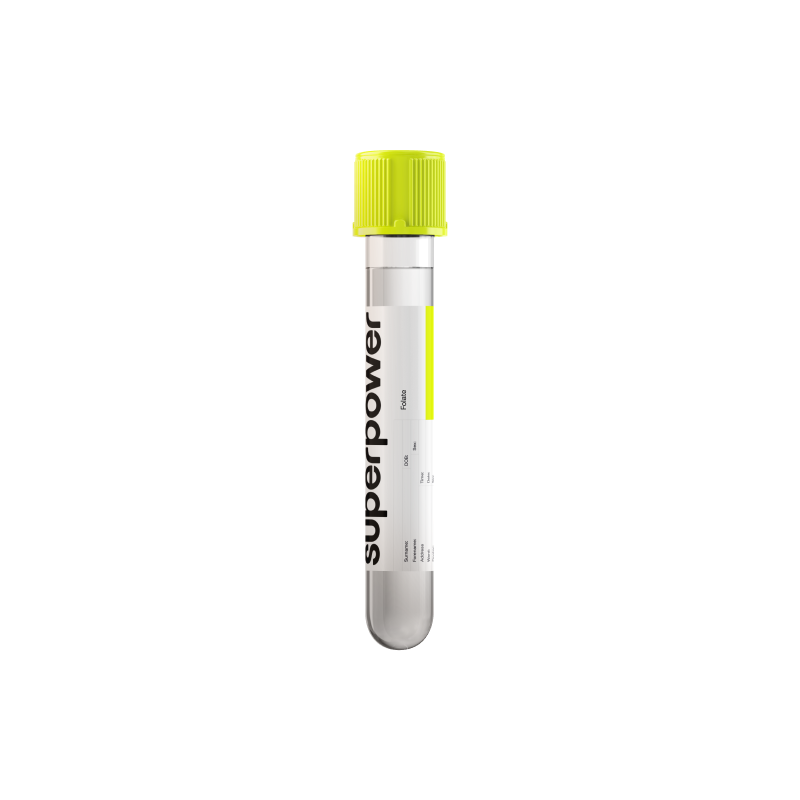See where your folate stands so you can personalize nutrition and supplementation, steady energy and mood, and keep homocysteine in check.
Key Benefits
- Check your folate status to support red blood cell production and DNA synthesis.
- Spot deficiency that can cause fatigue, mouth sores, and macrocytic anemia.
- Clarify anemia patterns by identifying folate shortage versus other causes.
- Guide targeted diet or supplements when low, improving intake from greens and legumes.
- Support reproductive health by ensuring levels needed for egg, sperm, and early embryo.
- Support pregnancy by reducing neural tube defect risk with adequate folate.
- Track recovery after malabsorption, bariatric surgery, alcohol use, or methotrexate therapy.
- Interpret results with vitamin B12 and a CBC to avoid missing B12 deficiency.
What is Folate?
Folate is a water-soluble B vitamin (vitamin B9) that your body must obtain from food or supplements. It occurs naturally in leafy greens, legumes, and citrus, and the synthetic form in supplements and fortified foods is folic acid. In the small intestine, folate is absorbed and converted in the liver and tissues to its active coenzyme forms, mainly tetrahydrofolate (THF) and 5-methyltetrahydrofolate (5-MTHF). These forms circulate in blood to supply cells, with the liver serving as a key storehouse.
Folate’s central job is to carry single-carbon units needed to build and regulate genetic material (one-carbon metabolism). It enables the synthesis of DNA and RNA bases (purines and thymidylate), supports normal cell division, and helps make healthy red blood cells. Folate also donates methyl groups for methylation reactions, including the remethylation of homocysteine to methionine, which links it closely to vitamin B12 function. By fueling these processes, folate underpins tissue growth and repair, brain and nerve development, and the body’s overall capacity to turn genes on and off appropriately.
Why is Folate important?
Folate (vitamin B9) powers one‑carbon metabolism—the chemistry that builds DNA and repairs tissues, turns genes on and off, and makes healthy red blood cells. Because of that, it touches brain function and mood, energy delivery, cardiovascular health via homocysteine, fertility, and fetal neural development.
Labs report folate as serum/plasma (short‑term) or red blood cell folate (long‑term stores). Reference ranges vary by lab; in general, people feel and function best with values in the middle to upper part of the range rather than hovering at the low cutoff.
When folate is low, the bone marrow cannot divide cells efficiently, producing large, fragile red cells (megaloblastic anemia). Fatigue, breathlessness, pale skin, sore tongue, and mouth ulcers are common, and the gut lining may thin, causing diarrhea. Homocysteine rises, stressing blood vessels. In pregnancy, low folate increases risk of neural tube defects. Children and teens—who are building tissues fast—may show anemia, poor appetite, and slowed growth.
High folate is most often due to recent intake from fortified foods or supplements and is usually asymptomatic. The key concern is that abundant folate can correct the anemia of vitamin B12 deficiency while nerve damage progresses, so high folate alongside low B12 or neurologic symptoms warrants attention. Transient high serum values can also reflect timing rather than true tissue excess.
Big picture: folate works hand‑in‑hand with vitamins B12 and B6 in methylation and amino acid metabolism, shaping vascular health, cognition, and cell renewal. Steady, adequate status supports genomic stability and healthy pregnancies; chronic deficiency strains blood, gut, and heart systems and can compound long‑term cardiovascular and cognitive risks.
What Insights Will I Get?
What Folate tells you
Folate measures the availability of this B vitamin for one‑carbon metabolism—how your body builds DNA and RNA, methylates proteins and lipids, and recycles homocysteine. Adequate folate supports steady red blood cell production, cardiovascular resilience, cognitive function, reproductive development, and immune cell turnover.
Low values usually reflect insufficient intake, malabsorption, higher needs (notably in pregnancy), alcohol use, or folate‑antagonist medications. Physiologically, limited folate impairs nucleotide synthesis, slowing cell division and red blood cell maturation, which leads to megaloblastic anemia and fatigue. Homocysteine often rises, stressing vascular endothelium. Rapidly renewing tissues (oral and gut mucosa) are vulnerable, and fetal neural tube formation is especially sensitive. Neurologic symptoms suggest coexisting low vitamin B12 rather than isolated folate lack.
Being in range suggests adequate one‑carbon flux, stable erythropoiesis, effective homocysteine remethylation, and reliable DNA repair. This usually aligns with good metabolic flexibility and tissue maintenance. Most clinicians interpret values comfortably above the deficiency threshold—often mid‑range—as biologically stable, though exact cutoffs vary by lab and assay.
High values usually reflect recent supplementation or fortified intake, causing a serum rise that may not indicate tissue excess. When vitamin B12 is low, high folate can correct anemia while neurological injury progresses, so discordant patterns warrant attention. Less commonly, liver disease or intestinal bacterial overgrowth can elevate circulating folate.
Notes: Serum folate tracks recent intake; red blood cell folate reflects longer‑term stores. Hemolysis can artifactually elevate serum results. Pregnancy lowers measured concentrations and has trimester‑specific norms. Antifolate and anticonvulsant drugs, alcohol use, genetic variants in MTHFR, and inter‑assay variability influence interpretation.



.svg)



.png)
.png)
.png)
.png)








